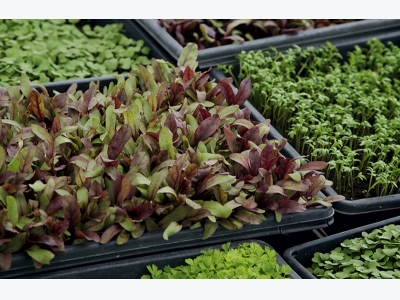Cropped: How to Grow Microgreens

Easy to start from seed. Ready for harvest in a mere two to four weeks. Able to thrive indoors when temperatures drop.
Microgreens represent more than just the latest culinary craze. They can also yield serious agricultural dividends without much of an investment in terms of money or space (see “The Bottom Line for Microgreens,” below). So what’s the catch? A shelf life that matches the crop’s short stature: one week, tops, even when refrigerated.
A general term, micro-greens refers to foliage harvested at the cotyledon growth stage (shortly after sprouting), and not a particular plant. In theory, any edible leaves qualify, but chefs and home cooks seek those with a unique flavor, color, or texture, such as radish and mustard greens (see “Microgreens to Try,” below).
Often confused with sprouts, microgreens differ in that they germinate in soil—not water—and are harvested later. The little leaves boast up to 40 times more nutrients, including vitamins C, E, and K, than their mature counterparts. Because chemicals, too, tend to be more highly concentrated in the young growth, be sure to choose organic seeds, which haven’t been treated with insecticides or fungicides.
Planting
Whether you’re growing indoors or out, plant the seeds in 1020 flats, elevated atop tables for ease in care and harvesting. Fill each flat with about an inch of organic potting soil, and sow the seeds across the top, aiming for a ratio of roughly 10 per square inch with smaller seeds and about half that with larger ones. Gently tamp down and water with a slow mist. Outside, position the tables in an area that receives at least 6 hours of sunlight daily. Inside, rely on warming mats and T5 fluorescent bulbs to provide the necessary heat and light. Cover each flat with plastic wrap to maintain humidity; remove at the first sign of germination. (While greenhouses offer a productive option for off-season growing, they can generate too much heat in the summer.)
Care and Harvesting
Since plants farmed for microgreens will never reach maturity, thinning isn’t necessary. Mist them daily after removing the plastic, to keep the soil moist but not wet. Continuous airflow is also important to prevent mold. Position a box fan so it blows directly over the flats, indoors or out. Microgreens are ready to be harvested as soon as they’ve produced their first true leaves, generally when the plants have reached ½ to 2 inches tall, two to four weeks after sowing, depending on the plant type. Due to their fragile nature, the baby leaves require careful handling. Cut them at soil level with a pair of sharp kitchen scissors directly into their final packaging. Then start your next growing cycle with fresh soil and seeds.
Marketing
Because they’re highly perishable, you don’t want to harvest more microgreens than you can sell in a given week. Start small while you build a client base. Should your supply outstretch demand, let the plants grow another couple weeks, and try marketing them as baby greens.
Microgreens to Try
Since virtually any edible harvested at the cotyledon stage qualifies as a microgreen, the options are almost endless. These represent some of the most popular fast and slow growers. Asterisks denote those that are particularly easy to germinate from seed.
Fast-Growing (2 weeks)
- Hong Vit radish* pinkstems; mild radish flavor
- Red cabbage purple-veined leaves; mild, sweet flavor
- ‘Kogane’ Chinese cabbage* bright-green leaves; mild cabbage flavor
- ‘Ruby Streaks’ mustard green and maroon leaves; sweet and spicy
- ‘Green Wave’ mustard green ruffled leaves; spicy
- Daikon radish white stems; spicy
- Cressida cress* three-lobed leaves; peppery
- Dark Purple mizuna light-purple stems; mild mustard flavor
Slow-growing (4 weeks)
- ‘Bright Lights’ chard* red, yellow, and pink stems; earthy flavor
- Cilantro green leaves; mild cilantro flavor
- Parsley* lobed green leaves; mild parsley flavor
- ‘Purple Delight’ basil purple leaves; sweet and spicy
- ‘Red Giant’ mustard green leaves with red veins; spicy
- Lemon basil shiny green leaves; spicy lemon flavor
- ‘Bull’s Blood’ beet red leaves; earthy, spinach- ike flavor
- Celery light-green leaves; mild celery flavor
The Bottom Line for Microgreens
Thanks to a short crop cycle and low start-up costs, commercial microgreen growers can make a handsome return—especially if they farm indoors during off seasons.
Cost per ¼-pound seed bag: $5–$35, depending on plant type
Seeds for forty 1020 flats: ¼ pound total
Maximum yield per forty 1020 flats: About 40 pounds total for each two- or four-week growing cycle
Price per pound:$20–$25 per pound if you’re selling in bulk to a commercial kitchen; otherwise, you’ll likely sell by the ounce, priced at around $2 per ounce
Maximum net revenue per forty 1020 flats: $975–$1,225 per growth cycle (calculations assume $15 for seeds plus equipment and soil start-up costs)
Related news
Tools

Phối trộn thức ăn chăn nuôi

Pha dung dịch thủy canh

Định mức cho tôm ăn

Phối trộn phân bón NPK

Xác định tỷ lệ tôm sống

Chuyển đổi đơn vị phân bón

Xác định công suất sục khí

Chuyển đổi đơn vị tôm

Tính diện tích nhà kính

Tính thể tích ao



 Cropped: Blackberries
Cropped: Blackberries  Cropped: How to Grow Lovage
Cropped: How to Grow Lovage